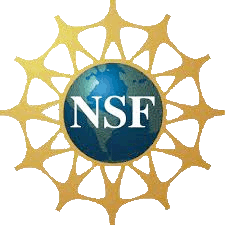| |
This class was developed under a
special grant from the National Science Foundation. Its
goal is to provide a lab-based hands-on introduction to
nanoscience and nanotechnology for early undergraduates
of any major (there are no pre-requisites beyond normal
college-track high school physics, chemistry &
math).
So what does this class
cover? First, at the nanoscale, we must confront the fact
that Newton’s sensible laws are replaced by the weirdness
of quantum mechanics (hence the class’s Wizard of Oz
subtitle). The details are bewildering, but for this class
you only need to know that electrons begin to act like
waves. But all waves act basically the same way. And that
means to anticipate how weird electron waves might behave,
we can (literally) start by experimenting with water waves
(for instance, water waves will explain why manufacturers
are putting nanoparticles into sun block).
The second thing that
changes at the nanoscale, is that WE can no longer
manufacture things directly. Micro-assembly techniques
(such as those used in making the integrated circuits of
your computer/cell phone/PDA) are based on
micro-photography. And images just won’t focus to smaller
than a wavelength of light (something we’ll also show with
the water waves). But light’s wavelength is at least 10X
too large to pattern things at the nanoscale. Instead we
have to rely on a process called “self-assembly.” That is,
we have to design the parts so they
know how we want them to finally come together.
The ultimate example of self-assembly? DNA synthesis of
protein. But DNA might also someday help us to
self-assemble nano electronic circuits. Some people spend
years studying self-assembly and DNA. But in this class
you’ll find that we can learn the essentials in just a few
classes.
But after you’ve
programmed the parts to “self-assemble” at the nanoscale,
how do you know if they got it right? One way is
to use distant cousins of the old-fashion record player
called the Atomic Force Microscope (AFM) and Scanning
Tunneling Microscope (whose invention earned two
researchers Nobel Prizes). We used the NSF grant to buy
six of these instruments. In the labs, you will use these
tools to see individual atoms. (To view our full
virtual reality recreations of these instruments, click on
the photos above).
Finally, we’ll also
discuss the boundary between nanoscience and
nanotechnology. There is a heck of a lot of the former but
not, as yet, a whole lot of the latter. The distinction
has produced immense confusion in media from Scientific
American to science fiction. What is real? What stands a
good chance (or virtually no chance) of ever becoming
real? And for the things that do become real, how might
they affect us, and the other inhabitants of this world?
| Textbook: |
Textbook:
Nanotechnology - Understanding Small
Systems, 3rd Edition, Ben Rogers,
Sumita Pennathur and Jesse Adams, CRC Press -
Taylor & Francis Group (2011), ISBN
978-1-4822-1172-6 |
NOTE: These web notes were
originally posted in only Microsoft Powerpoint
format. However, Powerpoint is now available only
via recurring annual payments. Such
payments could place an unacceptable financial
burden upon lower income students, teachers, and
retirees. Thus, as of March 2019, I have
converted each note set into three formats;
MS Powerpoint, Adobe PDF, and Apple Keynote (I
have also updated & corrected embedded web
links).
|
|
|

